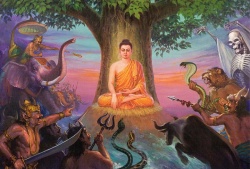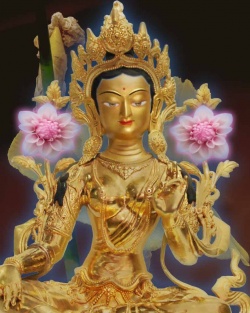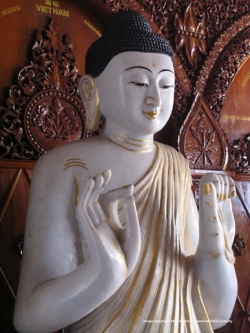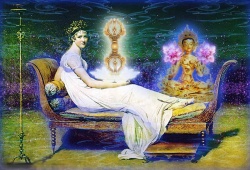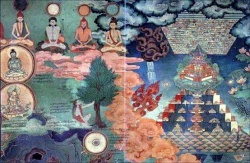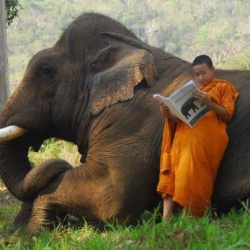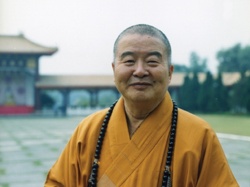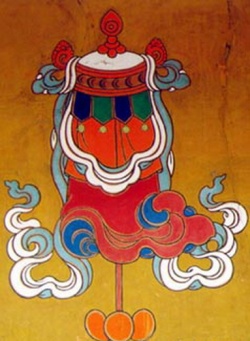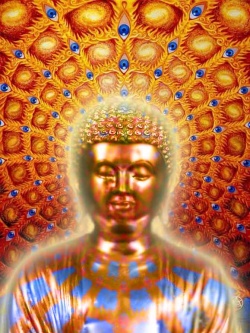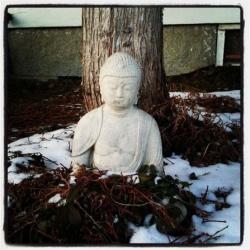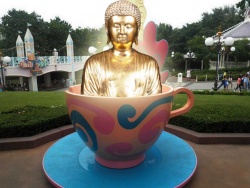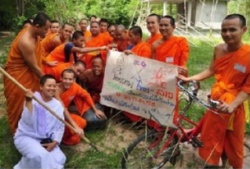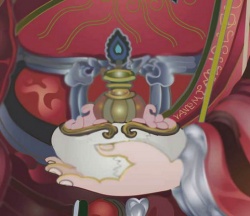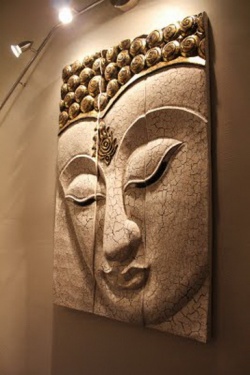On the Four Stages of Faith and the Five Stages of Practice
four stages of faith and the five stages of practice
四信五品 (Jpn shishin-gohon )
Stages of faith in and practice of the Lotus Sutra formulated by T'ient'ai (538-597) in The Words and Phrases of the Lotus Sutra on the basis of the "Distinctions in Benefits" (seventeenth) chapter of the Lotus Sutra. The four stages of faith are for those who embrace the Lotus Sutra during Shakyamuni's lifetime, and the five stages of practice are for believers in the sutra after Shakyamuni's death. The four stages of faith are
(1) to believe in and understand the sutra even for a moment,
(2) to generally understand the import of the words of the sutra,
(3) to expound the teaching of the sutra widely for others, and
(4) to realize with deep faith the truth expounded by the Buddha.
The five stages of practice are
(1) to rejoice on hearing the Lotus Sutra,
(2) to read and recite the sutra,
(3) to expound the sutra to others,
(4) to embrace the sutra and practice the six paramitas, and
(5) to perfect one's practice of the six paramitas.
In On the Four Stages of Faith and the Five Stages of Practice, Nichiren (1222-1282) defines the correct stage for practitioners in the Latter Day of the Law to be the first of the four stages of faith and the first of the five stages of practice, that is, to believe in and understand the Lotus Sutra even for a moment and to rejoice on hearing the sutra. See also four stages of faith.
I HAVE received the string of blue-duck coins1 that you sent. Scholars of Buddhism these days all agree on the following: Whether in the Buddha’s lifetime or after his passing, those who wish to practice the Lotus Sutra must devote themselves to the three types of learning. If they neglect any one of these, they cannot attain the Buddha way.
In the past, I, too, subscribed to this opinion. Setting aside here the sacred teachings of the Buddha’s lifetime as a whole, let us examine the question in the light of the Lotus Sutra. Here, too, we may set aside the teachings contained in the preparation and revelation sections.2 That brings us to the transmission section, which constitutes a clear mirror for the Latter Day of the Law and is most to be relied upon [in determining this matter].
The transmission section has two parts. The first is that of the theoretical teaching and consists of the five chapters beginning with the “Teacher of the Law” chapter. The second is that of the essential teaching and consists of the latter part of the “Distinctions in Benefits” chapter through the eleven chapters that comprise the remainder of the sutra. The five chapters from the theoretical teaching and the eleven and a half chapters from the essential teaching combine to make sixteen and a half chapters, and in these it is clearly explained how one should practice the Lotus Sutra in the Latter Day of the Law. If this is not convincing enough, then further examining the matter in light of the Universal Worthy and Nirvana sutras3 will surely leave no doubt.
Within these chapters of transmission, the four stages of faith and the five stages of practice expounded in the “Distinctions in Benefits” chapter refer to what is most important in the practice of the Lotus Sutra, and are a standard for those living in the time of the Buddha and after his passing.
Ching-hsi4 writes, “‘To produce even a single moment of belief and understanding’ represents the beginning in the practice of the essential teaching.”5 Of these various stages, the four stages of faith are intended for those living in the Buddha’s lifetime, and the five stages of practice, for those living after his passing. Among these, the first of the four stages of faith is that of producing even a single moment of belief and understanding, and the first of the five stages of practice is that of rejoicing on hearing the Lotus Sutra. These two stages together are the treasure chest of the hundred worlds and thousand factors and of three thousand realms in a single moment of life; they are the gate from p.784 which all Buddhas of the ten directions and the three existences emerge.
The two sage and worthy teachers T’ien-t’ai and Miao-lo established these two initial stages of faith and practice, and put forth three interpretations concerning them. One equates them with the stage of resemblance to enlightenment, the ten stages of faith, and the stage of the iron-wheel-turning king.6 The second equates them with the first of the five stages of practice, which are identified with the stage of perception and action, at which one has not yet severed the illusions of thought and desire. The third equates them with the stage of hearing the name and words of the truth.
In reconciling these differences of interpretation, Great Concentration and Insight states: “The Buddha’s intentions are difficult to determine. He explained things differently according to the differing capacities of his listeners. If only we understand this, then what need is there for troublesome disputes?”
My opinion is that, of the three interpretations, the one that refers to hearing the name and words of the truth accords best with the text of the Lotus Sutra. For, in describing the first of the five stages of practice that apply to the time after the Buddha’s passing, the sutra speaks of those who “[hear this sutra and] do not slander or speak ill of it but feel joy in their hearts.”7 If one equates the stage described here with a level as advanced as the five stages of practice at the stage of resemblance to enlightenment, then the words “do not slander or speak ill of it” would hardly be appropriate.
In particular, the passages in the “Life Span” chapter that speak of those who are “out of their minds” and those who are “not out of their minds” refer in both cases to the stage of hearing the name and words of the truth.8 The Nirvana Sutra says, “Whether they have faith or do not have faith . . . ,” and “If there are living beings who, in the presence of Buddhas numerous as the sands of the Hiranyavati River, have conceived the desire for enlightenment, then when they are born in an evil age such as this, they will be able to accept and uphold a sutra like this and will never slander it.”9 One should also consider these passages.
Again, in the four-character phrase “a single moment of belief and understanding,” the word “belief” applies to the first of the four stages of faith, and the word “understanding,” to those that follow. And if this is so, then faith without understanding would apply to the first of the four stages of faith. The second stage of faith is described in the sutra as that at which one “generally understands the import of the words”10 of the sutra. And in volume nine of The Annotations on “The Words and Phrases of the Lotus Sutra” we read, “The initial stage of faith is different from the others, because in the initial stage there is as yet no understanding.”
Then we come to the following “Responding with Joy” chapter, where the initial stage of rejoicing on hearing the Lotus Sutra is restated and clarified in terms of fifty persons who in turn hear and rejoice in the Lotus Sutra, the merit that they gain thereby decreasing with each successive person. With regard to the stage achieved by the fiftieth person, there are two interpretations. The first interpretation holds that the fiftieth person falls within the stage of rejoicing on hearing the Lotus Sutra.11 The other interpretation holds that the fiftieth person cannot yet be said to have entered the stage of rejoicing on hearing the Lotus Sutra but is still at the stage of hearing the name and words of the truth. This is what one commentary means when it says, “The truer the teaching, the lower the stage [of those it can bring to enlightenment.”12 Thus, for example, the perfect teaching can save people of lower p.785capacity than can the doctrines of the four flavors and three teachings. Similarly, the Lotus Sutra can save people of lower capacity than can the perfect teaching expounded prior to the Lotus Sutra, and the essential teaching of the Lotus Sutra can save more people than can the theoretical teaching—people of any capacity at all. One should carefully ponder the six-character phrase: “the truer the teaching, the lower the stage.”
Question: In the Latter Day of the Law, is it necessary for beginners in the practice of the Lotus Sutra to devote themselves to all three types of learning associated with the perfect teaching?
Answer: This is a very important question, and so I will be consulting the text of the sutra in answering you. In describing the first, second, and third of the five stages of practice, the Buddha restricts those at these stages from practicing precepts and meditation, and places all emphasis upon the single factor of wisdom. And because our wisdom is inadequate, he teaches us to substitute faith for wisdom, making this single word “faith” the foundation. Disbelief is the cause for becoming an icchantika and for slander of the Law, while faith is the cause for wisdom and corresponds to the stage of hearing the name and words of the truth.
T’ien-t’ai states: “When persons have reached the stage of resemblance to enlightenment, the benefits they have accrued will not be forgotten when they are reborn in another existence. But for persons at the stage of hearing the name and words of the truth or at the stage of perception and action, those benefits will be forgotten when they are reborn in succeeding existences, though there may be some among them who do not forget. Even in the case of persons who have forgotten those benefits, if they should encounter a good friend, then the roots of goodness that they planted in their previous existences will be revived. If they encounter an evil friend, they will lose their true mind.”13
This is probably what happened to the two eminent men of these middle days, the great teachers Jikaku and Chishō of the Tendai school. They turned their backs upon the teachings of T’ien-t’ai and Dengyō, who had been good friends to them, and instead transferred their allegiance to Shan-wu-wei, Pu-k’ung, and others, who were evil friends. And many of the scholars in the latter age have been deluded by Eshin’s introduction to his Essentials of Rebirth in the Pure Land and have as a result lost the true mind of faith in the Lotus Sutra, giving their allegiance instead to the provisional teachings associated with Amida. They are persons who have abandoned a great doctrine and instead chosen lesser doctrines. If we judge from examples in the past, they will probably suffer for countless kalpas in the three evil paths. It is persons such as these that T’ien-t’ai meant when he said, “If they encounter an evil friend, they will lose their true mind.”
Question: What proof can you offer to support your claim?
Answer: Volume six of Great Concentration and Insight states: “Persons who are saved by the teachings preached previous to the Lotus Sutra are those who have reached a high level of attainment. The reason is because these teachings are mere expedients. Those saved by the perfect teaching of the Lotus Sutra belong to a low level of attainment, because this teaching represents the truth.”
The Annotations on “Great Concentration and Insight” comments on this as follows: “This passage concerning the teachings preached previous to the Lotus Sutra makes clear the relative worth of the provisional and the true teachings, because it indicates that the truer the teaching, the lower the stage [of those it can bring to p.786enlightenment]. Conversely, the more provisional the teaching, the higher must be the stage [of those who embrace it in order to attain enlightenment.” And volume nine of On “The Words and Phrases” says, “In determining a person’s stage of attainment, the more profound the object of meditation, the lower will be the level of the practitioner [who can attain enlightenment thereby].”
I will say nothing here about followers of other schools, but why would scholars of the Tendai school set aside this interpretation that “the truer the teaching, the lower the stage,” and instead accept the writings of the Supervisor of Priests Eshin? The teachings of Shan-wu-wei, Chin-kang-chih, and Pu-k’ung, and those of Jikaku and Chishō, can wait until later. This is a matter of utmost importance, the most important in the entire land of Jambudvīpa. Thinking persons should listen to what I say. After that, if they wish to reject me, let them do so.
Question: For practitioners in the Latter Day of the Law, who have just aroused the aspiration for enlightenment, what types of practice are restricted?
Answer: Such persons are restricted from practicing almsgiving, the keeping of the precepts, and the others of the five pāramitās, and are directed to chant Nam-myoho-renge-kyo exclusively. This practice corresponds to the capacity of persons at the stages of “producing even a single moment of belief and understanding” and “rejoicing on hearing the Lotus Sutra.” It represents the true intention of the Lotus Sutra.
Question: I have never before heard such an assertion. It astonishes my mind and makes me wonder if my ears have not deceived me. Please clearly cite some passages of scriptural proof and kindly explain.
Answer: The sutra says, “[Such persons] need not for my sake erect towers and temples or build monks’ quarters or make the four kinds of offerings to the community of monks.”14 This passage from the sutra makes it quite clear that practitioners who have just aroused the aspiration for enlightenment are restricted from almsgiving, the keeping of the precepts, and the others of the five pāramitās.
Question: The passage you have just quoted restricts us only from erecting temples or towers, or providing for the community of monks. It says nothing about the keeping of the various precepts and the other practices.
Answer: The passage mentions only the first of the five pāramitās, that of almsgiving, and skips mention of the other four.
Question: How do we know this?
Answer: Because a subsequent passage, in describing the fourth stage of practice, goes on to say, “How much more is this true of those who are able to embrace this sutra and at the same time dispense alms, keep the precepts . . . !” The sutra passages clearly indicate that persons at the first, second, and third stages of practice are restricted from practicing almsgiving, the keeping of the precepts, and the others of the five pāramitās. Only when they reach the fourth stage of practice,15 are they permitted to observe them. And because such practices are permitted only at this later stage, we may know that, for persons in the initial stages, they are restricted.
Question: The sutra passages you have just quoted seem to support your argument. But can you offer any passages from the treatises or commentaries?
Answer: What commentaries would you like me to cite? Are you referring to the treatises by the four ranks of sages of India, or to works written by Buddhist teachers of China and Japan? In either case, it amounts to rejecting the root and searching among the p.787branches, seeking the shadow apart from the form, or forgetting the source and prizing only the stream. You would ignore a sutra passage that is perfectly clear and instead seek an answer in the treatises and commentaries. But if there should be some later commentary that contradicts the original sutra passage, would you then cast aside the sutra and follow the commentary?
Nevertheless, I will comply with your wishes and cite some passages. In volume nine of The Words and Phrases of the Lotus Sutra it is stated: “There is a danger that a beginner will be led astray by subordinate concerns, and that this will interfere with the primary practice. The beginner should directly give all his attention to embracing this sutra; that is the highest type of offering. If one sets aside formal practices but maintains the principle, then the benefits will be many and far-reaching.”
In this passage of commentary, “subordinate concerns” refers to the five pāramitās. If the beginner tries to practice the five pāramitās at the same time that he embraces the Lotus Sutra, that may work to obstruct his primary practice, which is faith. Such a person will be like a small ship that is loaded with wealth and treasure and sets out to cross the sea. Both the ship and the treasure will sink. And the words “should directly give all his attention to embracing this sutra” do not refer to the sutra as a whole. They mean that one should embrace the daimoku, or title, of the sutra exclusively and not mix it with other passages. Even recitation of the entire sutra is not permitted. How much less are the five pāramitās!
To “set aside formal practices but maintain the principle” means that one should set aside the keeping of the precepts and the other formal practices [of the five pāramitās and embrace the principle of the daimoku exclusively. When the commentary says that “the benefits will be many and far-reaching,” it implies that, if the beginner should attempt to carry out various other practices and the daimoku at the same time, then all benefit will be completely lost.
Words and Phrases continues: “Question: If what you say is true, then upholding the Lotus Sutra is the foremost among all the precepts. Why, then [in describing the fourth stage of practice, does the Lotus Sutra speak about ‘one who can keep the precepts’? Answer: This is done in order to make clear by contrast what is needed at the initial stages. One should not criticize persons at the initial stages for failing to observe requirements that pertain only to the later stages.”16
The scholars of today, ignoring this passage of commentary, would place ignorant people of the latter age in the same category as the two sages Nan-yüeh and T’ien-t’ai—a most grievous error!
Miao-lo further clarifies the matter as follows: “Question: If that is so, then is there no need to construct actual towers to house the Buddha’s relics, and is there no need to formally keep the precepts? And further, is there no need to provide alms for monks who carry out the formal practices [of the six pāramitās?”17
The Great Teacher Dengyō declared, “I have forthwith cast aside the two hundred and fifty precepts!”18 And the Great Teacher Dengyō was not the only one to do so. Nyohō and Dōchū,19 who were disciples of Ganjin, as well as the priests of the seven major temples of Nara, all in like manner cast them aside. Moreover, the Great Teacher Dengyō left this warning for future ages: “If in the Latter Day of the Law there should be persons who keep the precepts, that would be something rare and strange, like a tiger in the marketplace. Who could possibly believe it?”20
Question: Why do you not advocate the meditation on the three thousand realms in a single moment of life, but instead simply encourage the chanting of the daimoku?
Answer: The two characters that comprise the name Japan contain within them all the people and animals and wealth in the sixty-six provinces of the country, without a single omission. And the two characters that make up the name India—do they not likewise contain within them all the seventy countries of India?21 Miao-lo says, “When for the sake of brevity one mentions only the daimoku, or title, the entire sutra is by implication included therein.”22 He also says, “When for the sake of brevity we speak of the Ten Worlds or the ten factors, the three thousand realms are perfectly encompassed therein.”23
When Bodhisattva Manjushrī and the Venerable Ānanda came to compile all the words spoken by the Buddha at the three assemblies during the eight years [in which the Lotus Sutra was preached, they wrote down the title Myoho-renge-kyo, and to show their understanding [that the entire sutra is contained in these five characters], they proceeded with the words “This is what I heard.”24
Question: If a person simply chants Nam-myoho-renge-kyo with no understanding of its meaning, are the benefits of understanding thereby included?
Answer: When a baby drinks milk, it has no understanding of its taste, and yet its body is naturally nourished. Who ever took the wonderful medicines of Jīvaka knowing of what they were compounded? Water has no intent, and yet it can put out fire. Fire consumes things, and yet how can we say that it does so consciously? This is the explanation of both Nāgārjuna and T’ien-t’ai, and I am restating it here.
Question: Why do you say that all teachings are contained within the daimoku?
Answer: Chang-an writes: “Hence T’ien-t’ai’s explanation of the title in] the preface conveys the profound meaning of the sutra. The profound meaning indicates the heart of the text, and the heart of the text encompasses the whole of the theoretical and essential teachings.”25 And Miao-lo writes, “On the basis of the heart of the text of the Lotus Sutra, one can evaluate all the other various teachings of the Buddha.”26
Though muddy water has no mind, it can catch the moon’s reflection and so naturally becomes clear. When plants and trees receive the rainfall, they can hardly be aware of what they are doing, and yet do they not proceed to put forth blossoms? The five characters of Myoho-renge-kyo do not represent the sutra text, nor are they its meaning. They are nothing other than the intent of the entire sutra. So, even though the beginners in Buddhist practice may not understand their significance, by practicing these five characters, they will naturally conform to the sutra’s intent.
Question: When your disciples, without any understanding, simply recite with their mouths the words Nam-myoho-renge-kyo, what level of attainment do they reach?
Answer: Not only do they go beyond the highest level of the four flavors and three teachings, as well as that attained by practitioners of the perfect teaching set forth in the sutras that precede the Lotus Sutra, but they surpass by a hundred, thousand, ten thousand, million times the founders of the True Word and various other schools of Buddhism, such as Shan-wu-wei, Chih-yen, Tz’u-en, Chi-tsang, Tao-hsüan, Bodhidharma, and Shan-tao.
Therefore, I entreat the people of this country: Do not look down upon my disciples! If you inquire into their past, you will find that they are great p.789bodhisattvas who have given alms to Buddhas over a period of eight hundred thousand million kalpas, and who have carried out practices under Buddhas as numerous as the sands of the Hiranyavati and Ganges rivers. And if we speak of the future, they will be endowed with the benefit of the fiftieth person, surpassing that of one who gave alms to innumerable living beings for a period of eighty years.27 They are like an infant emperor wrapped in swaddling clothes, or a great dragon who has just been born. Do not despise them! Do not look on them with contempt!
Miao-lo writes, “Those who vex or trouble [the practitioners of the Lotus Sutra will have their heads split into seven pieces, but those who give alms to them will enjoy good fortune surpassing the ten honorable titles.”28 King Udayana behaved insolently toward the Venerable Pindolabhāradvāja, and within seven years lost his life.29 The lord of Sagami condemned Nichiren to exile, and within a hundred days armed rebellion broke out in his domain.30
The sutra says: “If anyone sees a person who accepts and upholds this sutra and tries to expose the faults or evils of that person, whether what he speaks is true or not, he will in his present existence be afflicted with white leprosy. . . . and other severe and malignant illnesses.”31 It also says, “That person will be born eyeless in existence after existence.”
Myōshin and Enchi32 contracted white leprosy in their present lifetime, while Dōamidabutsu lost his sight. The epidemics that afflict our nation are punishments of the kind described as “the head being split into seven pieces.” And if we surmise the degree of benefit according to the degree of punishment, then there can be no doubt that my followers “will enjoy good fortune surpassing the ten honorable titles.”
The Buddhist teachings were first introduced to Japan in the reign of the thirtieth sovereign, Emperor Kimmei. During the twenty reigns, or more than two hundred years, from that time until the reign of Emperor Kammu, although the so-called six schools of Buddhism existed in Japan, the relative superiority of the Buddhist teachings had not yet been determined. Then, during the Enryaku era (782–806), a sage appeared in this country, a man known as the Great Teacher Dengyō. He examined the teachings of the six schools, which had already been propagated, and made all the priests of the seven major temples of Nara his disciples. In time he established a temple on Mount Hiei to serve as the head temple, and won over the other temples in the country to serve as its branches. In this way the Buddhist teachings of Japan came to be unified in a single school. The secular rule likewise was not divided but clearly established, so that the nation was purified of evil. If we were to speak of Dengyō’s accomplishments, we would have to say that they all spring from the passage [declaring the Lotus Sutra to be foremost among all the sutras the Buddha “has preached, now preaches, and will preach.”33
In the period that followed, the three great teachers Kōbō, Jikaku, and Chishō, claiming to be following Chinese authority, expressed the opinion that the Mahāvairochana Sutra and the others of the three major True Word sutras are superior to the Lotus Sutra. Moreover, they appended the term “school” to the True Word teachings, a term that the Great Teacher Dengyō had purposely omitted in reference to that school, and thus recognized the True Word as the eighth school34 of Buddhism. These three men each persuaded the emperor to issue an edict upholding the True Word and propagated those teachings p.790 throughout Japan, so that every temple accordingly went against the principles of the Lotus Sutra. In so doing, they utterly violated the passage concerning the sutras the Buddha “has preached, now preaches, and will preach,” and became archenemies of Shakyamuni, Many Treasures, and the Buddhas of the ten directions.
Thereafter, Buddhism gradually declined and the ruler’s authority likewise became increasingly ineffectual. The protective deities who had dwelt here for so long, such as the Sun Goddess and Great Bodhisattva Hachiman, have lost their power. Brahmā, Shakra, and the four heavenly kings have deserted the country, and the country is already on the point of ruin. What thinking person could fail to be pained at and to lament such a situation?
In conclusion, the false doctrines propagated by the three great teachers are disseminated from three temples: Tō-ji, Sōji-in on Mount Hiei, and Onjō-ji.35 If measures are not taken to prohibit the activities of these temples, then without a doubt the nation will be destroyed, and its people will fall into the evil paths. Although I have generally discerned the nature of the situation and informed the ruler, no one has ventured to make the slightest use of my advice. How truly pitiable!
Background
This work is one of Nichiren Daishonin’s ten major writings. It is thought to have been written on the tenth day of the fourth month in the third year of Kenji (1277). In the previous month, Toki Jōnin, one of the Daishonin’s most learned and devout disciples, had sent him a letter via Nisshō, one of the six senior priests. Toki had expressed concern about how he might carry out a correct practice and appended a list of specific questions. This work is the Daishonin’s reply. In it he stresses that chanting Nam-myoho-renge-kyo with faith in the Mystic Law is the correct practice for the Latter Day of the Law and contains the merit of all other practices within it, leading directly to Buddhahood.
In the opening section, the Daishonin takes issue with those of his contemporaries who hold that practitioners of the Lotus Sutra must devote themselves to the three types of learning: precepts, meditation, and wisdom. These three were traditionally said to encompass the whole of Buddhist practice. The Daishonin begins his explanation by discussing the “four stages of faith and the five stages of practice” enumerated by the Great Teacher T’ien-t’ai on the basis of the “Distinctions in Benefits” chapter of the Lotus Sutra. The first stage of faith, that of “producing even a single moment of belief and understanding,” and the first stage of practice, that of “rejoicing on hearing the Lotus Sutra,” correspond to the status of practitioners in the Latter Day of the Law, the Daishonin says. Among various interpretations of these initial stages set forth in the recorded teachings of T’ien-t’ai and Miao-lo, he designates as most appropriate the view that they correspond to the stage of hearing the name and words of the truth, the stage where one first hears and takes faith in the Lotus Sutra. For people at these initial stages, the Daishonin continues, of the three types of learning, the Buddha restricted the practice of precepts and meditation, emphasizing only wisdom. And, because the wisdom of people in the Latter Day is inadequate, they p.791should substitute faith; faith in the Lotus Sutra becomes the cause for acquiring the Buddha wisdom.
The Daishonin then criticizes Eshin’s Essentials of Rebirth in the Pure Land, a work that had greatly encouraged Nembutsu practices in Japan. Pure Land adherents generally held that the Lotus Sutra was too profound for the limited capacities of people born in the Latter Day, emphasizing instead the “easy practice” of reciting Amida Buddha’s name. The Daishonin replies that the higher the teaching, the lower the capacity of the people it can save; thus chanting the daimoku, or title, of the Lotus Sutra alone can bring all beings to Buddhahood.
The next part explains that people in the Latter Day, who are at the initial stages of practice, need not practice almsgiving, the keeping of precepts, or any other of the five pāramitās, but should devote themselves exclusively to chanting the daimoku. It may be noted here that the Daishonin is not rejecting the spirit implicit in such acts as almsgiving, but rather is denying their efficacy as actual practices. The merit of all these good deeds, he says, is already inherent in the daimoku. The practice of daimoku contains all practices within itself. The Daishonin asserts that even those who chant it without understanding its meaning are certain to attain Buddhahood.
Back to Top
Notes
1. Blue-duck coins were copper coins imported from Sung-dynasty China, with a square hole in the center that made them look like a duck’s eye.
2. The preparation and revelation sections are the first two of the three divisions of a sutra, the third being transmission. In the subsequent paragraph, the transmission section is applied to both the theoretical teaching and the essential teaching of the Lotus Sutra. In terms of the theoretical teaching, it corresponds to the “Teacher of the Law” (10th) through “Peaceful Practices” (14th) chapters. In terms of the essential teaching, it corresponds to the latter part of the “Distinctions in Benefits” (17th) chapter through the end of the sutra, as well as the Universal Worthy Sutra.
3. According to the T’ien-t’ai system of classification, these two sutras represent the last that Shakyamuni Buddha expounded. The Universal Worthy Sutra is regarded as an epilogue to the Lotus Sutra, and the Nirvana Sutra, as a restatement of its important teachings. Thus, in a broad sense, these two texts can be said to constitute the transmission section of the entire body of teachings.
4. Another name for the Great Teacher Miao-lo. Ching-hsi was the name of his birthplace.
5. The Annotations on “The Words and Phrases of the Lotus Sutra.”
6. The stage of resemblance to enlightenment is the fourth of the six stages of practice, and the ten stages of faith indicate the first ten of the fifty-two stages of bodhisattva practice. According to commentarial tradition, the various kinds of wheel-turning kings are used to represent different divisions within the fifty-two stages of bodhisattva practice. The lowest ranking of the kings, he who turns the iron wheel, represents the initial stages, the ten stages of faith.
7. Lotus Sutra, chap. 17.
8. The reference here is to the parable of the skilled physician, whose sons swallow poison in his absence. Some are only mildly affected and retain their right mind, while others take leave of their senses. The physician (who represents the Buddha) offers to cure them with good medicine (the Lotus Sutra), but only those who are still in their right mind take it and are cured. As an expedient to save the others, the physician leaves home and has word sent that he has died in another country. In their grief, those children who have lost their minds finally decide to take the medicine and are cured. The Daishonin says here that both groups of children represent persons at the stage of hearing the name and words of the truth, because both have heard the Lotus Sutra.
9. In the Japanese text, the Daishonin p.792gives only a few characters from each passage; the full quotations are supplied here in translation. The Hiranyavati River flows through Kushinagara, the capital of the ancient state of Malla in northern India. Shakyamuni is said to have entered nirvana in a grove of sal trees on the west bank of this river.
10. This phrase actually appears in The Words and Phrases of the Lotus Sutra, where T’ien-t’ai comments on a passage of the “Distinctions in Benefits” chapter of the Lotus Sutra that reads, “If there is someone who, hearing of the long duration of the Buddha’s life span, can understand the import of such words, the benefits that such a person acquires will be without limit or measure, able to awaken in him the unsurpassed wisdom of the True Come One.”
11. This interpretation corresponds to the second of the three interpretations of the initial levels of practice, cited earlier, in which the five stages of practice, including that of “rejoicing on hearing the Lotus Sutra,” are equated with the stage of perception and action.
12. The Annotations on “Great Concentration and Insight.” This passage consists of six Chinese characters in On “Great Concentration and Insight.”
13. The Profound Meaning of the Lotus Sutra.
14. Lotus Sutra, chap. 17. This quotation comes from the passage describing the second of the five stages of practice, that of reading and reciting the Lotus Sutra. The four kinds of offerings are food and drink, clothing, bedding, and medicine.
15. The fourth stage of practice is that of practicing the six pāramitās while embracing the Lotus Sutra.
16. The wording of the Japanese text has been expanded here in translation for the sake of clarity.
17. On “The Words and Phrases.” The implication is that, for those at the initial stages, such acts are included in faith.
18. The Documents Pertaining to “A Clarification of the Precepts.” Dengyō rejected the two hundred and fifty precepts of Hinayana, while embracing the bodhisattva precepts of Mahayana.
19. Nyohō (Chin Ju-fa, d. 814), a Precepts priest, accompanied his teacher Ganjin (Chien-chen) to Japan, where he conferred precepts on Emperor Kammu. Dōchū (n.d.) was a Japanese Precepts priest, under whom Enchō, the second chief priest of Enryaku-ji, first entered the priesthood. In saying that Ganjin and his disciples cast aside the two hundred and fifty Hinayana precepts, the Daishonin may be referring to the fact that Ganjin was the first to bring to Japan the writings of T’ien-t’ai, on which Dengyō based his understanding of the Mahayana precepts.
20. The Treatise on the Lamp for the Latter Day of the Law. This work is traditionally attributed to Dengyō.
21. The seventy countries of India refer to the whole of India. The source for this figure may be Hsüan-tsang’s Record of the Western Regions.
22. On “The Words and Phrases.”
23. The Annotations on “The Profound Meaning of the Lotus Sutra.”
24. “This is what I heard” is the opening phrase of the Lotus Sutra, and of virtually all sutras.
25. Profound Meaning. This passage appears in Chang-an’s preface to Profound Meaning and refers to T’ien-t’ai’s own preface to the same work.
26. On “The Profound Meaning.”
27. Lotus Sutra, chap. 18.
28. On “The Words and Phrases.” “Have their heads split into seven pieces” refers to the vow made by the ten demon daughters in chapter 26 of the Lotus Sutra to afflict in this way anyone who troubles a teacher of the sutra. The ten honorable titles are epithets for the Buddha expressing his virtue, wisdom, and compassion.
29. This story appears in The Fourfold Rules of Discipline. Udayana was the king of Kaushambi in Shakyamuni’s time. He revered the Buddha’s disciple Pindolabhāradvāja and visited him every day. His jealous minister persuaded the king that Pindolabhāradvāja was insufficiently respectful and urged him to kill the disciple if the latter did not rise to greet him. Knowing this with his supernatural powers, Pindolabhāradvāja rose from his seat to save the king from the offense of killing a disciple of the Buddha, but as a result of his own ill intent, the king was soon captured by an enemy ruler and died within seven years.
30. Lord of Sagami is another name for Regent Hōjō Tokimune. The “armed rebellion” refers to an attempt on the part of his elder half brother, Hōjō Tokisuke, to usurp the regency in the second month of 1272.
31. Lotus Sutra, chap. 28. The quotation p.793immediately following is also from this chapter.
32. Myōshin, a priest-disciple of the Daishonin, later discarded his faith and turned against him. Enchi was a priest of Seichō-ji temple, where the Daishonin had entered the priesthood. The Actions of the Votary of the Lotus Sutra suggests that he was slanderous at heart and met with a miserable death (p. 777).
33. Lotus Sutra, chap. 10.
34. Eighth school: That is, in addition to the six schools and the Tendai school.
35. Temples descending, respectively, from the three great teachers Kōbō, Jikaku, and Chishō. See Tō-ji and Onjō-ji in Glossary. Sōji-in was founded on Mount Hiei by Jikaku in 851 as a center for esoteric practice.

